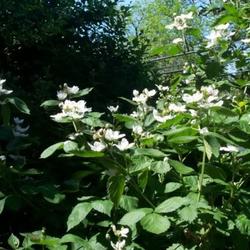Valuable source of nectar and white grey pollen for honey bees. They also get honeydew from this plant.

Native in the Pacific NW, from Alaska to California, east to the Dakotas and New Mexico. Found in open to wooded, moist to dry areas, often in areas recently cleared or logged. The berries are edible but rather insipid, although the birds like them. The fruit is hollow when picked, resembling a thimble.

Valuable source of nectar and light grey pollen for honey bees. They also get honeydew from this plant.

This perennial-like small shrub has a native range from southeast Canada & New England & New York down into Georgia & Alabama up into Indiana to northern Illinois. Its 2 inch wide rose-purple flowers are fragrant. Its raspberries are edible but not very flavorful. It spreads by stolons (stems along the ground) to become a mounded colony. It is sold by some native plant nurseries. I have only seen a few of this species planted around in a few landscapes. It is a nice plant.

I just bought one of the thornless blackberry plants. So far, it has produced 3 berries and rooted 3 starts. I am looking forward to what the next season will bring.

This is a thornless blackberry with erect canes. It is notable for being resistant to orange rust, which was the deciding factor for me in choosing this cultivar over others. I previously lost my entire blackberry stand to orange rust.

Southern Dewberry is a trailing, vine-like woody perennial; a native here in Florida and found throughout the state. Growing to 10 feet in height, the plant has intertwining branches with short downward pointing barbs along the length of the stems. The stiff, compound dark green leaves have coarse, toothed edges and appear along spiny stalks. The large, solitary flowers are borne on short, prickly flower stalks. Flowers are 3/4 to 1 1/2 inches wide, with 5 white oblong petals that are often tinged with pink. Fruit is a 1/2 to 1 1/4 inch rounded red berry that turns black at maturity and looks similar to a blackberry. Southern Dewberry is found in habitats of dry woods, along roadsides in thickets and pinelands.

If leaves begin to yellow or droop in summer - apply a balanced liquid fertilizer and water well.

I believe this to be the best tasting berry of all. Not dry like a raspberry, seedy like a blackberry, sour like a gooseberry, or pithy like store bought strawberries. It's wonderful cooked or fresh. Grows on second year vines. Thornless version still has small thorns, original version (bigger thorns like blackberry vines) sets more fruit. Hard to find if you want to buy.

Native in the Pacific NW from Alaska to California, east to Idaho. Found in moist woods and swamps to mid elevations in the mountains. The berries can be either bland or stunningly sweet, randomly. They are quick to mush, so don't pack them too deep when picking. The berries ripening is associated with the song of the Swainson's thrush, which is often referred to as the salmonberry bird. It forms a nice screening hedge, without too many prickles.
